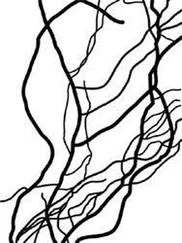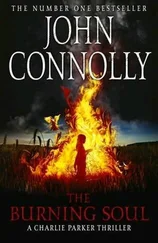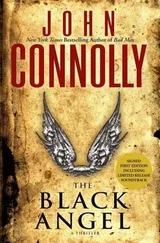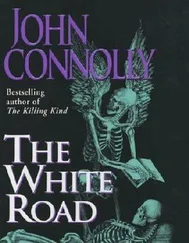He grabbed a pair of coal tongs and followed his wife. From behind the kitchen door came another bellow, and the sound of dishes smashing on the tiled floor. Mrs. Mayer entered the kitchen to find the demon standing amid the wreckage of her second-best crockery.
“Right, you!” said Mrs. Mayer. “That’s quite enough of that.”
The demon turned, bared its teeth, and caught a poker straight between the eyes. It staggered slightly, then seemed about to recover itself when the next blow sent it to its knees. Meanwhile a second demon, smaller than the first, had just entered through the back door. Mr. Mayer caught it by the snout with the coal tongs and twisted hard. The demon let out a pained howl as Mr. Mayer forced it backward and then, holding on to the tongs with his left hand, began to bang the demon across the head with a dustbin lid.
“That’s.” Crash! “For.” Smash! “Messing.” Thud! “Around.” Whack! “With.” Thump! “My.” Whomp! “Roses!”
When he had finished, the demon lay unmoving upon the ground. The red light faded from its eyes, before disappearing entirely. In the kitchen, Mrs. Mayer was growing tired of hitting the demon with the poker, which was just as well as it had stopped moving some time before, and its eyes had also gone dark.
Mr. Mayer stood in the yard, the tongs in one hand, the dustbin lid in the other, like a knight of old, albeit one who couldn’t afford proper weapons. From the rose garden, two more demons watched him warily as their fallen comrades began to disappear in wisps of foul-smelling purple smoke.
“Now listen here,” said Mr. Mayer. “I’m going to count to five, and by then you’d better be off those roses, or you’ll get what your friends got. One.”
While the demons had no idea what Mr. Mayer was saying, they were smart enough to understand what he meant.
“Two.”
He began moving in their direction. Mrs. Mayer appeared behind him, brandishing the poker. The demons exchanged a look, and the universal nod of those who have decided that it would be a smart thing to make themselves very scarce as soon as demonically possible. They squatted down, and with a single leap propelled themselves over the six-foot-high garden wall, then, not to put too fine a point on it, scarpered.
Mr. Mayer walked to the rose garden where he stared down upon his beloved bushes, now trampled into the dirt. Only one remained standing: the original bush. It had survived everything that man and nature could throw at it, and it wasn’t about to be crushed by any horde, demonic or otherwise.
Mr. Mayer lay down his tong sword and dustbin lid shield and patted its bare branches fondly.
“It’s all right, little one,” he said. “We’ll start again come spring…”
XXI In Which the Verger Is Assaulted, and a Very Unpleasant Person Comes Back to Life
THE VICAR AND VERGER were preparing the Church of St.Timidus for the following day’s early morning service when they heard what sounded like a brick dislodging from the stonework high above their heads and falling to the ground outside. Both men looked a little concerned, as well they might. The church was very old, and in a poor state of repair. Reverend Ussher was always worried about the roof falling in, or the brickwork collapsing. Now it seemed that his worst fears were coming true.
“What was that?” he asked the verger. “A slate falling?”
“It sounded a bit heavier than a slate,” said Mr. Berkeley, who was a fat little man. Both the vicar and the verger were fat little men. They had played Tweedledum and Tweedledee in the local drama society’s version of Alice in Wonderland earlier that year, and very good they were too.
The two men went to the front door of the church and unlocked it. They were about to step outside when a small, stunned stone gargoyle staggered from a nearby holly bush, its heavy wings beating slowly. It was a most ugly creature, more so even than the average gargoyle. Bishop Bernard the Bad had supervised its creation, just as he had every other detail of the church’s construction. This explained why it was a dark, gloomy building, and why all of the faces and creatures carved on its stonework were hideous and scary.
The vicar and verger watched, openmouthed, as the gargoyle rubbed its head. Small streaks of blue lightning flashed across its body. It coughed once, and spat out what looked like old pigeon feathers.
The gargoyle was very confused. It had wings, but it didn’t seem able to fly. When it had come to life, the first thing it had done was attempt to soar elegantly into the air. Unfortunately, things made out of stone don’t tend to soar terribly well, so the gargoyle had simply dropped off its perch. Even though it wasn’t very intelligent, it knew the difference between flying and falling. It now also knew the difference between landing and just hitting the ground very hard.
More gargoyles, each one uglier than the last, began to descend upon the church lawn. One of them struck a tree and broke on impact, but most seemed to survive the drop more or less intact. Once they had recovered from their shock, they began to converge on the main door of the church where Reverend Ussher and Mr. Berkeley were standing, rooted to the spot in amazement. They might have remained that way too, had the verger not been hit on the side of the head with a sharp piece of masonry.
“Oh, you’re in trouble now,” said a voice. Mr. Berkeley looked to his left and saw that the faces carved into the stonework of the church had also come to life, and the head of a monk, with a pair of hands supporting his chin, was talking to him. At least the hands should have been supporting his chin, but one of them had clearly just thrown a piece of brickwork at the verger’s head.
The verger tapped the vicar’s shoulder.
“The monk on the wall is talking to us,” he said.
“Oh,” said the vicar. He tried to sound surprised, but couldn’t quite manage it.
“Oi!” said the stone monk. “Fatties! I said, You’re in trouble now.’”
“Why would that be?” asked the vicar, tearing his eyes from the approaching gargoyles.
“End of the world,” said the stone monk. “Hell is opening up. The Big Bad is coming. The Great Malevolence. Wouldn’t want to be in your shoes. He doesn’t like humans.”
The stone monk seemed to consider something for a moment.
“Actually he doesn’t like anyone, but especially not humans.”
“I say,” said the vicar, “you’re part of the church’s stonework. Aren’t you supposed to be on our side?”
“Nah,” said the stone monk. “Infused with the bishop’s evil, we are. Couldn’t be nice if we tried.”
“The bishop’s evil?” said Reverend Ussher. He thought about that for a moment, until another piece of masonry was picked from the church and thrown hard at the verger, who did a little skip in order to avoid it.
“Oooh,” said the monk. “Tubby’s a dancer.”
“You’re a nasty piece of stonework!” said the verger.
The monk stuck its fingers in its ears and blew a raspberry at him.
“Sticks and stones, Tubby,” it said. “Sticks and stones…”
One of the gargoyles reached the vicar’s foot, opened its mouth, and bit down hard. Fortunately, the vicar had been working in his garden that afternoon, and was still wearing his favorite steel-toed work boots. The gargoyle lost its fangs and immediately looked a bit sorry for itself.
“Inside,” said Reverend Ussher. “Quickly!”
He and the verger retreated into the church and locked the door. Outside, they could hear gargoyles beating against the wood and scratching at the lock, but the door was very old and very thick, and it would take more than a bunch of foot-high stone monsters to break it down.
Читать дальше












